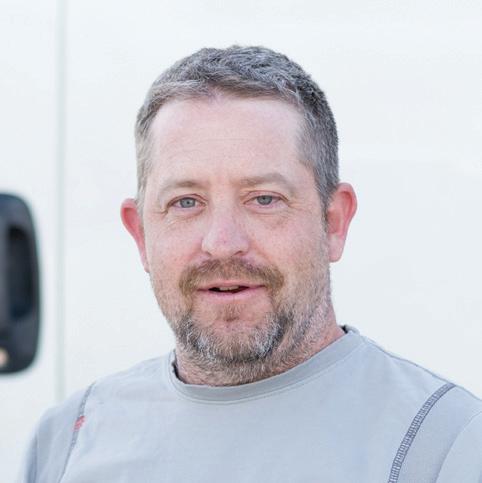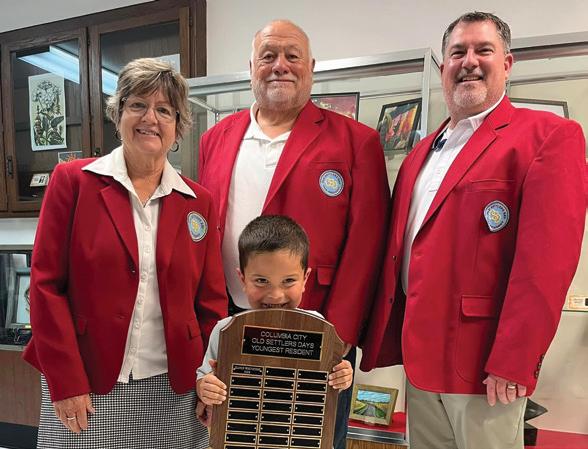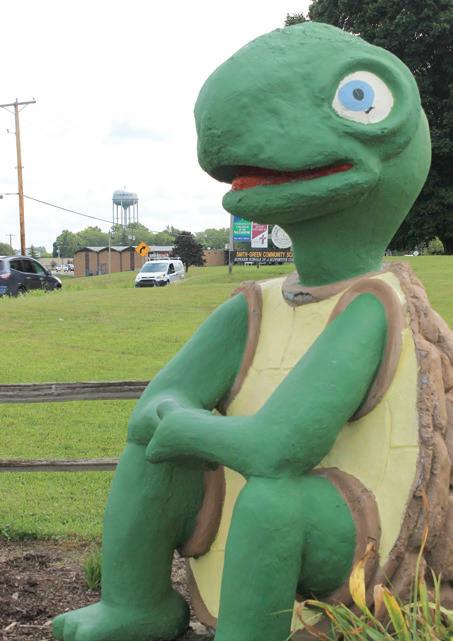Youth Tour participant reflects on a trip of a lifetime


Youth Tour participant reflects on a trip of a lifetime

Indiana Unclaimed Property reunites
Hoosiers with abandoned cash and valuables
Pages 20-25
JANUARY

It’s officially 2025, a new year full of new possibilities. Did you stay up until midnight to see the ball drop? My friends and I used to ring in the new year at fancy parties in downtown Indianapolis. Now, we celebrate in our sweatpants. (My favorite way to celebrate almost anything.) I suppose that’s what happens as you get older.
Many people use the turning over of the calendar to reset and think about how they can better themselves. That’s where New Year’s resolutions come in.
When I think of resolutions, I think of the typical ones — losing weight, starting a workout routine, eating less junk food or fast food. Many people’s resolutions are health-related, and keeping your health in mind is always good. Financial resolutions are also popular, such as putting away a little money every month, not eating out for lunch every day, or not buying a coffee every morning. Some people strive to give back more throughout the year.
I’m not really a resolution person. If I have a goal I want to meet, I don’t need to wait for a specific day to get started. However, I can see the merit in why the beginning of January can inspire change. Day one of the new year can be an excellent time to start day one of a new routine. Resolutions are notoriously hard to keep. Most people go into them with the best intentions and forget about them by March. I’ve heard it takes 21 days to form a new habit or lose an old one. Here’s hoping by the time you read this, you’re on your way to successfully fulfilling a resolution that benefits you for the better — whatever that may be.


Britt Davis Editor bdavis@indianaec.org
On the menu: April: Submit your favorite single-serve dessert recipes, deadline Feb. 3. If we publish your recipe on our food pages, we’ll send you a $10 gift card.
Giveaway: Enter to win a winter emergency car kit. Visit indianaconnection.org/talk-to-us/contests or send your contact information to the address below. The deadline to enter is Jan. 31.
Three ways to contact us: To send us recipes, photos, letters and entries for gift drawings, please use the forms on our website indianaconnection.org; email info@indianaconnection.org; or send to Indiana Connection, 11805 Pennsylvania Street, Carmel, IN 46032.
VOLUME 74 • NUMBER 7 ISSN 0745-4651 • USPS 262-340
Published monthly by Indiana Electric Cooperatives
Indiana Connection is for and about members of Indiana’s locally-owned, not-for-profit electric cooperatives. It helps consumers use electricity safely and efficiently; understand energy issues; connect with their co-op; and celebrate life in Indiana. Over 311,000 residents and businesses receive the magazine as part of their electric co-op membership. The average printed and mailed cost per issue is 54 cents.
CONTACT US: 11805 Pennsylvania Street Carmel, IN 46032
317-487-2220
info@indianaconnection.org IndianaConnection.org
INDIANA ELECTRIC COOPERATIVES OFFICERS: Steve McMichael President
Dr. Richard Leeper Vice President
Jamey Marcum Secretary/Treasurer
John Cassady CEO
EDITORIAL STAFF:
Britt Davis Editor
Holly Huffman Communication Support Specialist
Lauren Carman Communication Manager
Kiley Lipps Graphic Designer
Ashley Curry Production and Design Coordinator
Amber Knight Creative Manager
Mandy Barth Vice President of Communication
ADVERTISING:
American MainStreet Publications
Cheryl Solomon, local ad representative; 512-441-5200; amp.coop
Paid advertisements are not endorsements by any electric cooperative or this publication.
UNSOLICITED MATERIAL:
Indiana Connection does not use unsolicited freelance manuscripts or photographs and assumes no responsibility for the safekeeping or return of unsolicited material.
SUBSCRIPTIONS:
$12 for individuals not subscribing through participating REMCs/RECs.
CHANGE OF ADDRESS:
If you receive Indiana Connection through your electric co-op membership, report address changes to your local co-op.
POSTAGE:
Periodicals postage paid at Indianapolis, Indiana, and at additional mailing offices.
POSTMASTER:
Send change of address to: Indiana Connection, 11805 Pennsylvania Street, Carmel, IN 46032. Include key number.
No portion of Indiana Connection may be reproduced without permission of the editor.




Jonesy’s
Embrace
Howard Park hosts fun winter events for the whole family (NOT IN ALL EDITIONS)
Forced bulbs allow for spring flowers without fall planting

Indiana’s Unclaimed Property, run by the attorney general’s office, distributes more than $1 million weekly to lucky Hoosiers. Learn more about the program’s origins and how to check if money awaits you in this month’s feature

CONTACT US
Office: 260-726-7121 / 800-835-7362
WEBSITE
www.jayremc.com
marketing@jayremc.com
OFFICE HOURS
8 a.m.-4 p.m., Monday-Friday
STREET ADDRESS
484 S. 200 W. Portland, IN 47371
MAILING ADDRESS
484 S. 200 W. Portland, IN 47371
To report a power outage, call 260-726-7121 or 800-835-7362, 24 hours a day, 7 days a week.
BOARD OF DIRECTORS
Kenneth Denton, Chairman Rick Dues
Bethany Edwards, Secretary
Dru Hall
Kent Homan
Phil Laux
Angela Lutes
Klint Moser
Ronald Smithson STAFF
Neil Draper President/CEO
Becky Napert Business Manager
Pete Byrum Operations Manager
Jeff Myers Engineering Manager
Carly Nichols
Marketing and Communications Coordinator
www.facebook.com/ JayCountyREMC
www.twitter.com/ RemcJay
www.instagram.com/ jaycountyremc
www.pinterest.com/ JayCountyREMC

Electricity is essential for nearly every aspect of daily life — so essential that we rarely think about how it’s produced and delivered to our homes. You might be surprised to learn that behind the scenes, a network of experts is working daily (and even by the minute) to anticipate how much electricity you need before you even use it.
We’re all connected to the electric grid, so ensuring the right amount of electricity for all involves a complex process of forecasting energy demand, planning for capacity, and securing enough supply to meet Americans’ needs.
First, electricity must be generated at a power plant using either traditional sources, such as coal, natural gas, or nuclear energy, or from renewable sources, such as solar, wind, or hydropower.
At Jay County REMC, we work closely with Wabash Valley Power Alliance (WVPA), our local wholesale power partner, to secure enough electricity for our communities. We use a diverse mix of energy sources to generate the power we deliver to your home or business. By maintaining a diverse energy mix — coal, natural gas, nuclear, and renewables like wind and solar — Jay County REMC has options to ensure reliable power at a competitive cost.
On a larger scale, electricity supply and demand across the country
are managed through a market that includes long-term planning agreements, where electricity is bought and sold, just like other common goods and services. Because Jay County REMC works with our wholesale power partner, which is also a cooperative, we can pool resources and expertise to deliver affordable power to our local communities.
Electricity supply changes throughout the day because demand fluctuates based on consumers’ needs. For example, Jay County REMC knows that we need to ensure more electricity in the mornings when you start your day and in the evenings when you cook dinner, run appliances, and watch TV. Demand also increases when weather patterns change, such as extremely warm or cold temperatures.
Other electric utilities across the country are managing the same task of balancing supply and demand, which is why we have a larger network of key players in place to ensure enough power is delivered across the grid. In most cases, the amount of electricity generated and how much is sent to specific areas are coordinated and monitored by regional transmission organizations (RTOs)
CONTINUED ON PAGE 6
CONTINUED FROM PAGE 5
and independent system operators (ISOs). In other areas, individual electric utilities perform these tasks.
RTOs, ISOs, and electric utilities act as air traffic controllers for the electric grid. They forecast when you, your neighbors, and communities across a large region will need more power. These organizations take measured steps to ensure there’s enough supply to meet demand.
As the energy sector undergoes rapid change, it’s important for all consumers to understand the basics of electricity supply and demand.
Electricity use in the U.S. is expected to rise to record highs this year and next, with the demand expected to at least double by 2050. At the same time, energy policies are pushing the early retirement of always-available generation sources, which will compromise reliable electricity.
Jay County REMC remains committed to providing affordable, reliable energy to the members we serve. That’s why we are preparing now for increased demand and other challenges that could compromise our local electric supply.
Managing the balancing act of electricity supply and demand is a complex job, so we have a network of utilities, power plant operators, and energy traffic managers to direct the electricity we need and keep the electric grid balanced.

NEIL DRAPER President/CEO
RESIDENTIAL AND FARM SERVICE
Service charge: $32 per month
Kilowatt-hour (kWh) charge:
• 0-500 kWh: $.0371/kWh
• 501-1,500 kWh: $.0191/kWh
• Over 1,500 kWh: $.0131/kWh
Power Cost Adjustment: $.092/kWh
Outdoor lights:
• 50-watt LED: $8.75 per month
• 400-watt MV: $13 per month
ELECTRIC WATER HEATERS 30 GALLONS OR LARGER
• Replacement of an existing electric water heater: $125
• Gas to electric replacement: $175
• New construction water heater: $200
Visit jayremc.com for guidelines and restrictions. Additional rebates can be found at powermoves.com
Taking steps to help your home heating system run more efficiently can reduce energy use and lower your winter bills. Check to see if any air vents are blocked by furniture, curtains or other items. Obstructed vents force your heating system to work harder than necessary and can increase pressure in the ductwork, causing cracks and leaks to form. If necessary, consider purchasing a vent extender, which can be placed over a vent to redirect air flow from underneath furniture or other obstructions.
Source: Energy.gov
Follow these simple steps for your chance to win a bill credit for $50 in electricity.
CLIP THE COUPON BELOW. Complete and return the form to the office with your monthly payment by the bill due date in order to be entered. Or, you can email your entry to marketing@jayremc.com.

student art calendars available Members can stop by the REMC office and pick up a free copy of the 2025 Cooperative Calendar of Student Art, illustrated by students from all over the Hoosier state while supplies last.
LEARNING CENTER PROVIDES RELIABLE AND AFFORDABLE CHILDCARE

Packaging, the Kohlers have long been thinking about a facility providing reliable and affordable childcare for their employees and the community. “They wanted their employees to be able to work
your children. Homan and Rines noted that there are different age rooms and programs, so while all the younger rooms might be full, the morning and afternoon sessions for older children still have space
center. It’s more than just a babysitter,” Homan explained. Following the Frog Street Curriculum for infants, toddlers, and preschool-aged children,
CONTINUED ON PAGE 8
CONTINUED FROM PAGE 7
Toddlertown offers engaging daily schedules. The children participate in dancing, music movement, circle time, sensory activities, outside play, and much more.
The most interesting thing I learned about the center is that every detail of your experience there boils down to your child’s specific needs. Because the
teachers have specialized degrees, they can work with children of all abilities and skill levels. This offers parents peace of mind, knowing that their children are getting the best care while they are at work.
If you have questions regarding availability at Toddlertown or would like to join their waitlist, visit their website at toddlertownelc.com or call the center at 260-502-5437.

by Carly Nichols Marketing and Communication Coordinator
Jay County REMC
One of Jay County REMC’s missions is to support the communities we serve. One way we do this is through our youth programs available to area students. These programs include the Cooperative Calendar of Student Art, Camp Kilowatt, and Indiana Youth Tour. The deadlines to apply for these programs are fast approaching, so interested students should apply today. For more information, visit jayremc.com.
To highlight the benefits that students receive from these programs, here is a first-hand account of the Indiana Youth Tour from Austyn LeMaster, Jay County’s REMC’s 2024 delegate.
The trip to Washington, D.C., was definitely a trip of a lifetime. I met many new people, made new friends, saw the Capitol, and had a lot of fun. Everyone was a little shy and quiet on the first day, and some were nervous. When we got to the hotel that night, we thought that we should play cards when we were done eating. We played for about two hours, and people started to open up a bit more.
The next day was driving about three hours to the Flight 93 memorial. The memorial had recordings of some of the calls from people on the plane,
and it was really interesting to hear them.
Tuesday was one of the days that I looked forward to. We would see the Gettysburg Battlefield, head to Washington, and go to the Washington Nationals baseball game. Gettysburg was very cool. I had always wanted to go there. Most of us thought it was just a couple of large fields soldiers fought in. We were completely wrong.
As we headed to Washington, we saw some hills and wooded areas. We arrived at the hotel and had time to relax for a while. Later, we came down to head to the game. Once we got to the stadium, it was packed. I thought a Tuesday night game wouldn’t be as full. We sat down in some pretty good seats and watched the Arizona Diamondbacks beat the Nationals. It was a good game.
Wednesday was Mount Vernon, the Marine Corps Museum, and the Youth Day program. I thought that Mount Vernon, home of President George Washington, was a cool place and I didn’t realize it was that big of a property. We got to visit the museum and see some of the actual items from the plantation.
When we went to the Marine Corps Museum, we didn’t realize that all of the equipment and tools in the museum were the real deal. They took molds of the Marines in combat and cast identical copies to put into the museum.

That night, we had the Youth Day program and dinner. Everyone traded their pins and met new people from different states. They had a speaker come in who was shot by his friend when he was young. He talked about his motivators and what kept him going. It was a very interesting speech. Thursday was Capitol Hill day. We toured the Capitol Building, met with some congressional representatives, and visited the Library of Congress, the White House, and the Jefferson Memorial. The Capitol Building tour
CONTINUED ON PAGE 29







On this enchanting 9-day cruise from Charleston to Amelia Island, experience the charm and hospitality of the South. In the comfort of our modern fleet, travel to some of the most beautiful historic cities in America. The fascinating sites you visit, the warm people you meet, and the delectable cuisine you taste, come together for an unforgettable journey. Small Ship Cruising Done


























Few people ponder the electricity powering their coffeemaker as they pour that first morning cup. For those at your local electric co-op, it’s nearly all they think about.
Meeting the demand for electricity is complex and has grown more challenging as policy, technology, and weather create new possibilities and peril. Fortunately, your local electric cooperative partners with its wholesale power provider — its generation and transmission cooperative — to ensure needs can be met all day, every day. Hoosier Energy serves distribution co-ops in the southern half of Indiana, and Wabash Valley Power Alliance serves co-ops in the northern half of the state.
Electricity demand constantly changes — at various times during the day and even throughout the year. Less electricity is consumed overnight while people sleep, for instance, compared to afternoons when families return home after
school and work and turn on televisions, stoves, and other appliances. Energy demand is higher in the summer and winter, when air conditioning and heating are frequently used, compared to the milder fall and spring months.
Electricity is generated by a variety of resources, underscoring the need to plan appropriately. Power plants such as coal, natural gas, and some hydroelectric dams are dispatchable power plants that generate electricity year-round. Resources such as solar energy and wind turbines are intermittent resources; they depend on external factors that cannot be controlled, such as sunlight or wind, to generate power.
Intermittent resources are a good supplement to the energy grid but require careful planning. During Indiana winters, solar panels do not produce nearly as much electricity as on clear summer days, while wind turbines generate more electricity in the winter than in summer.
That’s where dispatchable plants are invaluable; they can be brought online to increase or decrease power generation to meet fluctuating demand. Electricity generators develop a portfolio with diverse resources to ensure that demand can be met 365 days a year. Electric distribution co-ops and generation and transmission cooperatives collaborate to ensure that they have the energy needed to power the communities they serve throughout their day — every day.

by Matt Walters Energy Advisor Boone REMC




































Home of “Turtle Town, USA,” Whitley County has the highest number on Indiana license plates, 92, because it’s last alphabetically in Indiana’s counties list. Whitley County also has six landmarks on the National Register of Historic Places, including the former home of Thomas R. Marshall, the 28th U.S. vice president.
Churubusco, Indiana, hosts a four-day festival each year to honor Oscar the Turtle, also known as the “Beast of Busco.” In 1948, residents claimed to have spotted a snapping turtle at Fulks Lake, describing it as having a shell as large as a dining table and a head the size of a child’s. Publications like the “Indianapolis Star” and “Life Magazine” came to cover the story, and nearly 400 cars an hour would drive by the lake to catch a glimpse of Oscar. However, Oscar was never captured or seen again, and Fulks Lake was eventually drained. The Turtle Days Festival at Churubusco Community Park celebrates this folklore with turtle races, baby crawling contests, carnival snacks, a parade, fireworks, and more.

Whitley County celebrates its residents each year with the Old Settlers’ Days Festival. The first gathering was held at Loon Lake in 1904, where attendees registered to create a permanent record of the community’s pioneers. Today, the festival honors the county’s oldest registered resident, longest continuous resident, and youngest resident. Their names are added to a plaque displayed at the Whitley County Historical Museum. The festival’s organizing committee, the Old Settlers’ Association, has donated more than $750,000 to the community through grants supporting local non-profits.


In 1949, Jerome Krider, the president of the Turtle Days Festival and Churubusco Little League, recognized a need for a permanent space for community gatherings and Boy Scout activities. Joe Luckey, the president of Churubusco State Bank, donated two acres of land for a new park. By 1951, a log cabin-style community building was built. Krider also helped construct the park’s basketball courts and baseball diamonds that are actively used today. The Churubusco Community Park now spans more than 60 acres and includes flower gardens, a splash pad, soccer fields, and more.
NAMED FOR:
Col. William Whitley, who fought in the Northwest Indian War and the War of 1812
POPULATION: 34,191
COUNTY SEAT: Columbia City
INDIANA COUNTY NUMBER: 92

The art contest for the 2026 Cooperative Calendar of Student Art has begun. Submissions for the contest should be mailed to the Indiana Connection office by Feb 28
for the Cooperative Calendar of Student Art Contest are
Connection by Friday, Feb. 28
A first-place winner will be selected for each grade, K-12, and will receive $200. The winning artwork will illustrate the cover and the 12 months inside. One “Best of Show” will be selected from the first-place winners and will win an extra $100. Additional artists from each grade will be selected for honorable mention awards and will receive $75 and have their works printed in a special section of the calendar.
The contest is open to Indiana public, private, or home-schooled kindergarten through 12th-grade students during the 2024-25 school year. A complete set of rules and required entry forms are available at indianaconnection.org/for-youth/art-contest
Do you have a cute or funny photo of your pets? Enter our photo contest. Submit a photo for the chance to be featured in the April issue of Indiana Connection. Our staff will pick their favorite photo, and the winner will receive an Amazon gift card.

Send a large, high-resolution photo at least 1 MB in file size to Editor Britt Davis at bdavis@indianaec.org by Feb. 18


Our Marketplace offers maximum exposure for your business or organization at a minimal cost.
Please contact Cheryl Solomon, 847-749-4875 or cheryl@amp.coop, for other small business advertising opportunities in Indiana Connection.



InAkron, Indiana, a cozy spot has quickly become a local favorite — Jonesy’s Junction. What started as a humble food venture in a tent in 2010 grew into a food trailer, and by 2016, owner Tim Jones opened the doors to his very own restaurant. Since then, Jonesy’s Junction has been serving up homestyle comfort food that keeps Akron residents coming back for more.
Jonesy’s Junction prides itself on offering high-quality ingredients. Their meats are never frozen, and the produce is always fresh. Jones, the mastermind behind it all, has built a loyal customer base by sticking to his roots and serving dishes that are both simple and satisfying.
Jonesy’s Junction’s menu is a tribute to classic American comfort food with a few standouts that have become specialties. The burgers are a crowd favorite, offering generous portions of perfectly seasoned, juicy beef topped with fresh fixings. Another standout is their hand-breaded pork tenderloin, which has earned rave reviews for its crisp exterior and tender, flavorful
Jonesy’s Junction offers fresh, high-quality comfort food to loyal customers
meat. Both dishes are made from scratch with attention to detail, making them feel like they were pulled from your family recipe book.
This winter, Jonesy’s is serving up comfort classics like pulled pork sandwiches, cheesy broccoli soup, Sloppy Joes, biscuits and gravy, patty melts, beef brisket, and mac and cheese.
But it’s not just the savory dishes that make Jonesy’s Junction special. Jonesy’s desserts are another reason to stop by. Their pies — freshly baked and filled with seasonal fruits — are the perfect ending to any meal. For a nostalgic treat, try their soft-serve ice cream, or choose a sundae featuring Jonesy’s hard-packed flavors for something a bit richer.
What began as a small operation has blossomed into a beloved neighborhood spot where comfort food reigns supreme. Jonesy’s Junction isn’t just a place to grab a bite; it reflects Jones’ passion for providing excellent comfort food to the Akron community.
For those craving a taste of homemade goodness, Jonesy’s Junction delivers — no frills, just great food served with a side of warmth and hospitality. Whether you’re in the mood for a hearty meal, a sweet treat, or just a place to relax, Jonesy’s Junction hits the spot.
Stephanie Bernaba is a freelancer with national reach who thrives on topics like food and entertainment.
“They
have the best tenderloin ever. Their prices are reasonable, and it's in a small town with that hometown feeling. Great food, great people. The owner is a down to earth, good person who loves animals.”

— Tammy J., Indiana Connection reader
Women are raving about the life-changing effects of this powerful formula.
There’s no denying that people — mostly women — are on a mission to discover the best way to eliminate fine lines and wrinkles permanently. The $14 billion dollars spent on aesthetic procedures in 2021 alone is a clear indication of that fact.
But now science appears to be offering a simpler solution. It’s a special delivery technology adapted for skincare that gets superior results.
Known as advanced liposome technology, this powerful distribution system ensures that vital nutrients are delivered exactly where your skin needs them the most, providing your skin with maximum anti-aging benefits.
Al Sears, MD, of Palm Beach, Florida, recently released an anti-aging cream that adapts this breakthrough medical technology into the realm of skincare, and he’s struggling to keep up with consumer demand.
Dr. Sears is South Florida’s leading anti-aging pioneer. He has authored over 500 reports, scientific papers, and books on anti-aging. A frequent lecturer at global anti-aging conferences, Dr. Sears spoke at the WPBF 25 Health & Wellness Festival featuring Dr. Oz, along with special guest, Suzanne Somers. Thousands of people were in attendance as Dr. Sears discussed his latest anti-aging breakthroughs.
This powerful cream, known as Restore, keeps selling out faster than it’s produced — and people are raving about the effect it’s having on their skin.
“Within a few minutes of applying the cream, it visibly plumps out the under-eye area and my cheeks
as well as those annoying lines that deepen as we age between the nose and lips. It also felt like it was tightening and smoothing my skin at the same time. I definitely feel I look younger whenever I use it,” said Amy B., of Montville, New Jersey.
“The lines around my mouth and eyes are filled in and my skin is tightened. I love having younger-looking skin, so I will continue using Restore” raves Cathy C., of Florida.
The best part is that this cream has no adverse side effects, doesn’t require a doctor’s visit or prescription, and is 100% natural.
“Advanced liposome technology ensures that vital nutrients are delivered exactly where your skin needs them the most.”
Powerful Delivery System Ensures Nutrients Penetrate Deep into Your Skin
The dermis is the underlying layer of skin that supplies nourishment and oxygen, and removes waste. In other words, it’s responsible for keeping your outer layer of skin healthy. Liposome technology is designed to support and nourish this deeper layer of skin by delivering nutrients directly to it.
“All of Restore’s powerful ingredients are encapsulated in a liposome shell — an organic container that carries the beautifying agents deep into the skin cells,” explained Dr. Sears.
“Restore’s liposome shell is composed of phosphatidylcholine or PC for short. While cell membranes repel water, they absorb PC because they’re actually made of it. As a result, Restore is delivered deep into

the cell for maximum firming and volume.”
When you apply liposome cream to your face, the liposomes in the skin cream work their way inside your skin, fuse with the skin cell membranes and then release their contents directly to the cells. Regular skin creams don’t have this capability.
Take Years off Your Face in Minutes
Once it’s penetrated the deeper layer of skin, Restore releases a unique blend of botanicals, vitamins and essential oils that reduces the appearance of fine lines and wrinkles, gives skin a more even tone, and moisturizes the interior layers of your dermal cells, firming and plumping your skin.
Restore’s first skin-enhancing agent is Madonna lily leaf stem cell extract. It helps produce an eventoned complexion. In a clinical study reported in the Journal of Cosmetic Dermatology, participants treated with this extract for 28 days showed improvements in skin luminance and tone around the eyes.
Restore is also loaded with vitamin C, which British researchers have found reduces both wrinkles and dryness. “In Restore we use magnesium ascorbyl phosphate, a more stable form of vitamin C
that doesn’t break down in liquid as does ordinary C,” explains Dr. Sears. “That means the antioxidant molecules stay intact within your skin cells where they can prevent damage from dangerous free radicals.”
This powerful formula also features guarana seed extract, coenzyme Q10, and avocado oil. Japanese researchers have also found that coenzyme Q10 supports production of the thin membrane that separates layers of your skin, and French studies have shown that avocado oil improves skin cell metabolism and enhances skin thickness.
To secure the hot, new Restore formula, buyers should contact the Sears Health Hotline at 1-800-6825732 TODAY. “It’s not available in retail stores yet,” says Dr. Sears. “The Hotline allows us to ship directly to the customer.” Dr. Sears feels so strongly about Restore, all orders are backed by a 100% money-back guarantee. “Just send me back the bottle and any unused product within 90 days from purchase date, and I’ll send you all your money back.”
Call NOW at 1-800-682-5732 to secure your supply of Restore. Use Promo Code ICRS125 when you call. Lines are frequently busy, but all calls will be answered!
Each season brings new opportunities and new weather concerns for Hoosiers. A winter day in Indiana can bring heavy snow, freezing rain, ice storms, and strong winds. These forms of winter weather can create electrical hazards.
“It’s important for Hoosiers to make sure they’re taking steps to be safe around electricity all year long, regardless of the weather outside,” said Jon Elkins, vice president of safety, training and compliance at Indiana Electric Cooperatives. “During winter, when snow and ice accumulation on power lines may cause them to snap or lead to poles breaking, people need to be particularly mindful of the dangers of live power lines.”
Here are some things to keep in mind with power lines and winter weather:
• Be sure to stay at least 35 feet away from a downed line . That’s about the length of three cars.

• Don’t touch the power line or anything in contact with it.
• Call 911 and tell others nearby to stay away.
• You should consider all downed lines live and dangerous. You or others could suffer serious injury or death.
It’s helpful to have winter storm safety kits for your home and on the go. You never know when you might be stuck at home for days, possibly some of that time without power, or get stranded on the roadway.
For your at-home kit, you will want at least two weeks of supplies, including:
• Bottled water
• Non-perishable food
• Emergency blankets
• First aid kit/medicine
• Flashlights
• Battery-operated or hand-crank radio
• Extra batteries
• Toiletries
For your vehicle, consider preparing a go-kit with at least three days of supplies to get you through the winter with these items:
• Blankets
• Warm clothes
• Jumper cables
• Bottled water
• Non-perishable food
• Sand or kitty litter to help with tire traction
• Critical backup batteries
• Chargers for your devices
During a winter storm, you may find yourself without power at home. If so, try to keep warm air in and cool air out by not opening doors to unused rooms and only opening doors to the outdoors if absolutely necessary.
Another thing to keep in mind with an extended outage is food safety. If the refrigerator reaches temperatures above 40 F, foods can become unsafe. You can help keep foods colder longer by leaving the refrigerator and freezer doors closed as much as possible.

















Embrace your sweet tooth with these decadent peanut butter desserts
Patricia Piekarski, Harvey, Illinois
1½ cups crushed graham crackers
1 ⁄ 3 cup dark brown sugar
3 Tbsp melted butter
16 oz. of cream cheese (two packages), room temperature
¼ cup granulated sugar
2 tsp vanilla
1 cup peanut butter
½ cup heavy cream
2 eggs
2 ⁄ 3 cup chocolate chips
Preheat the oven to 300 F. Line two muffin tins with 16 paper liners. In a bowl, combine the graham crackers with the brown sugar and butter. Press into the cupcake liners. Combine cream cheese, sugar, and vanilla in a bowl and beat well on medium speed. Add the peanut butter and heavy cream and beat until fully mixed. Add eggs and mix until combined. Spoon the cheesecake mixture on top of the crusts. Sprinkle with chocolate chips. Bake for 20 to 25 minutes. Cool completely in the refrigerator.


Doris Ann Kahlert, Berne, Indiana ½ cup buttermilk
FOR THE CAKE:
2 sticks margarine
1 cup water
1 cup peanut butter
2 cups granulated sugar
½ tsp salt
2 cups flour
1 tsp baking soda
1 tsp vanilla
2 eggs
FOR THE FROSTING:
1 stick margarine
½ cup peanut butter
½ cup buttermilk
2 2 ⁄ 3 cups powdered sugar
1 tsp vanilla
Add the margarine, water, and peanut butter to a pan and bring to a boil over medium heat. Shut off the heat and add the sugar, salt, buttermilk, flour, baking soda, vanilla, and eggs. Mix well and pour into a greased and floured sheet cake pan. Bake at 350 F for 20 to 25 minutes or until a toothpick comes out clean.
To make the frosting, put margarine, peanut butter, and buttermilk in a pan and bring it to a boil over medium heat. Shut off the heat and add powdered sugar and vanilla, mixing well. Then, turn the heat on low until the sugar is well incorporated. Frost the cake while the cake and frosting are still warm.
Martha Wiser-Partin, Corydon, Indiana
1 lb. confectioner’s sugar
1 ⁄ 3 cup of instant nonfat dry milk
¼ cup butter
1 ⁄ 3 cup crunchy peanut butter
½ cup light corn syrup
1 Tbsp water
1 tsp vanilla
1 cup miniature marshmallows
Optional: ½ cup chopped peanuts or pecans
Sift together sugar and milk. Set aside. Melt the butter and peanut butter in a 2-quart double boiler over boiling water. Stir in corn syrup, water, and vanilla into the melted peanut butter mixture, then add marshmallows. Stir until marshmallows are melted. Remove from heat and blend in sifted sugar and milk. If desired, add chopped peanuts or pecans. Pour into a greased 8- or 9-inch square pan. Cool in the refrigerator or a cool area and cut into squares. Makes 1¾ pounds.

BY BRIAN D. SMITH

You’ve heard the old saying: “If it sounds too good to be true, it probably is.” But when the state says it has unclaimed property in your name, you can take that to the bank — literally.
One of eight divisions within the Indiana attorney general’s office, the unclaimed property unit distributes more than $1 million weekly to lucky Hoosiers, which might sound like a waste of tax dollars. But in fact, it’s the recipients’ money to begin with, and like the finder of a lost dog, the state is simply helping to reunite it with its rightful owners.
It’s just that with 5.1 million unclaimed property accounts worth a total of $914 million, the job of owner locating is considerably more complicated than responding to a “lost dog” poster. Happily, it’s easier than ever to track down
abandoned cash and valuables bearing your name, thanks to the unclaimed property division’s searchable website, indianaunclaimed.gov.
But first things first: What exactly is unclaimed property, and are your odds of finding lost money any better than, say, winning the lottery?
As the attorney general’s office explained, “Any financial asset with no activity by its owner for an extended period is considered unclaimed property. This includes unclaimed wages or commissions, savings and checking accounts, stock dividends, insurance proceeds; underlying shares, customer deposits or overpayments, certificates of deposit, credit balances, refunds, money orders, and safe deposit box contents.”

Your chances of finding unclaimed property in your name are an estimated 1 in 7 — slightly better than the 1 in 292 million possibility of winning the Powerball jackpot. Plus, you can’t go broke trying your luck in the unclaimed property giveaway since it costs nothing to search online.
The highest claim paid this year was a whopping $750,000 — the state won’t identify the recipient — and even an average claim amounts to $1,018. But in the interest of managing expectations, it’s useful to remember that threefourths of all accounts contain $100 or less.
And some low-end claims aren’t worth the cost of mailing the check, such as the 50 cents awaiting a citizen of Pendleton, Indiana.
Still, whether it’s $20 or $50 or “over $100” — as the state’s online search engine describes any sum above the century mark — it’s never a bad day when you learn that you’re entitled to money you didn’t even know you were owed. An Indianapolis woman discovered as much when the search engine matched her name to a $248 check from an insurance company that she couldn’t even remember doing business with.
Keep in mind that not all unclaimed property comes with a dollar sign. Abandoned safe deposit boxes surround all manner of colorful cargo, including jewelry, rare coins, and collectibles, not to mention the occasional personal item — sometimes too personal.
Through the years, the state has taken possession of such items as false teeth, locks of hair, steamy love letters, and even ladies’ undergarments.
On a historic note, forgotten safe deposit boxes in Indiana have held Civil War discharge papers and a lapel pin from Lincoln’s inaugural ball. And in 1985, the state received some of the ultimate unclaimed property — the neverreturned contents of safe deposit boxes from 15 Indiana banks that failed during the Depression.
All tangible items of value that remain unspoken for are auctioned off, with one exception: the state does not sell military medals.
If searching for abandoned cash sounds like an exciting new endeavor, you might be surprised to hear that unclaimed property is neither new nor unique. According to the attorney general’s office, every state maintains a central location where people and businesses can search for long-lost assets. Indiana got in the game in 1967 when lawmakers passed a bipartisan bill giving the state the authority to collect abandoned property from banks, insurance companies, utilities, and other businesses. Though their actions would make thousands of residents a bit richer, their motives were not entirely altruistic.
The chief priority was to replenish Indiana’s Common School Fund for public school construction, which had run out of cash.
continued on page 22
continued from page 21
Although the state attempted to notify the rightful owners by running legal advertisements in newspapers across Indiana, no one seriously believed that most of the money would ever be returned. Proponents of the bill predicted it would generate millions of dollars, and sure enough, Indiana Attorney General John J. Dillon reported in 1968 that the state had collected $3.3 million worth of unclaimed assets and expected to have $2.8 million left over for the school fund.
tangible property started going on the online auction block on eBay.
After receiving a claim form, she completed it and sent it back, but her trek through a tangle of red tape was only beginning.
Whether it’s $20 or $50 or “over $100”, it’s never a bad day when you learn that you’re entitled to money you didn’t even know you were owed.
“ “
Legal ads served as the first notifications for owners of unclaimed property, but evolving technology has given the state more ways of connecting Hoosiers with their lost money. In 1988, an unclaimed property exhibit at the Indiana State Fair featured a computer that offered free searches for fair-goers. In 1994, the database went online, though in a primitive form.
More recently, the unclaimed property website has offered not only searches but also the ability to stake claims with the click of a mouse. And in 2021,
Perhaps the most famous unclaimed property owner in Indiana history was also the most persevering. It started in 1973 when a Fort Wayne girl’s long-inactive school savings account at Lincoln National Bank wound up with the unclaimed property division in Indianapolis. An inquiry by the girl’s mother, Ivadine Long, brought her a claim form, but it seems she never returned it. A year later, the same bank forwarded another dormant school savings account, also bearing the name of Ivadine’s daughter, Shelley Lee.
That’s right: The two savings accounts, totaling $247.06, belonged to future “Cheers” star Shelley Long.
But she wasn’t famous for anything in 1975 when she decided to contact the attorney general’s office about recovering her lost money. Then living in Evanston, Illinois, she signed her name “Shelley Long Solomon,” having wed for the first time four years earlier.
The state repeatedly moved the goal posts, first demanding a marriage certificate because her last name had changed and then, after receiving such proof in 1977, insisting it now needed a passbook with a guaranteed signature, a bank card, or an affidavit from a third party connecting her to the property, and photocopies of both notary public commissions.
It would be another seven years before the unclaimed property division heard from the Fort Wayne native again. By that time, Shelley Long was an Emmy Award-winning actress with a return address of Paramount Studios in Los Angeles, and her letter was the talk of the Statehouse. She found a more sympathetic ear from division director Calvin Kuhn, who approved her request after she submitted a notarized claim form. A $247.06 check payable to Shelley Lee Long was sent on Oct. 3, 1984 — six days after the start of the third “Cheers” season.
continued on page 24

Of the 5.1 million unclaimed property accounts in Indiana, none has a more mysterious owner than Sejdo Ustavdic. In 1989, before the state stopped publishing the exact value of accounts exceeding $100, he ranked No. 1 on the most-owed owner list with an abandoned bank account of $38,320.08.
Today, Sejdo Ustavdic has 129 accounts containing savings bonds valued at “over $100” apiece. Simple math tells us they’re worth at least $13,000 and perhaps more – especially if they contain any of the $38,000 from 35 years ago. Then again, these accounts weren’t reported until 2016.
Whatever the origin, it’s a lot of money to leave behind. So who was Sejdo Ustavdic, and why hasn’t he, or his heirs, come to collect the thousands of dollars he’s entitled to?
Unclaimed property records say only that Ustavdic once lived at a couple of addresses in Gary. You have to look farther, across two continents and an ocean, to uncover the surprising — and surprisingly poignant — story of his life. Although all such research runs the risk of confusing identically named individuals, the records uncovered in this case seem to point to the same person.
A search on Ancestry.com returns two documents, including the 1958 naturalization record of a Sejdo Ustavdic, who was born in 1910, lived in Gary, and took his oath of citizenship at the U.S. District Court in Hammond.
The second document, a yellowed ship’s passenger list, notes that on August 21, 1951, a 41-year-old single man named Sejdo Ustavdic — born “about 1910” — journeyed from Bremerhaven, Germany, to New Orleans on the U.S.S. General Taylor.
But this was no routine voyage. The document came from the Arolsen Archives, known as “the largest archive on the victims of Nazi persecution,” and the ship was carrying

war refugees to freedom. As the National WWII Museum website explained, “After World War II, 1.2 million Eastern European displaced persons remained in Germany and refused to return home.” Many feared living in nations now trapped behind the Iron Curtain of Soviet influence.
A “displaced persons statistical card” from the same archives reveals even more about Ustavdic’s life. He was born in Austria-Hungary, which became Yugoslavia after World War I, and he spoke Croatian (thus, his first name would have rhymed with “Play-Doh”). He was an unskilled laborer who had worked as a farmhand, fruit picker, and shoemaker.
How he became a displaced person is not written. It’s possible that he lost family members in the war or was imprisoned in a Nazi concentration camp, even though his religion is listed as “Mosl” — a likely abbreviation for Moslem, the archaic term for Muslim.
Regardless, what the statistical card tells us is sad enough: He entered Austria in September 1945 — the month World War II ended — and lived in a refugee facility known as Camp Wegscheid. The Jewish organization ORT said Wegscheid was “seriously overcrowded and did not have anywhere near enough living space. There were also problems with inadequate food supplies and quality.” Yet Ustavdic apparently spent all or part of six years there before finally getting permission to come to America.
What happened to him after his 1958 naturalization ceremony is untold. Did he find work in Gary’s steel mills and stash away most of what he earned, only to die before he could spend it? Did he leave behind only distant relatives in Europe?
The answers remain elusive. But if it means anything, there’s a vacation rental on the Croatian island of Korcula featuring kitchenettes, a private entrance, and balcony views of the Adriatic Sea. Its name is Apartments Ustavdic.
continued from page 22
How does an unclaimed property search work?
Following the previously provided link to the Indiana Unclaimed website, you will see a gold rectangle containing the words “Claim yours” on the right side of the screen. Clicking on that rectangle takes you to a different screen with the heading “Search for unclaimed property” and a form with five blank spaces.

There is no need to fill in every blank — one keyword or number in the first space (“Last or business name”) is enough to get the search engine running. But unless you have an uncommon surname or business name, you should add a first name or zip code; otherwise, you will be dealing with a parade of page numbers at the bottom of the screen. For instance, “Smith,” “Jones,” and other common names span 50 pages with 20 claims per page, whereas “Superman” returns just a single claim.
Your search needn’t end with your own name. If you want to help a good cause but are too lean in the green to contribute, you can arrange a “non-donation” of sorts. Just plug in a name or term representing a church, organization, or interest,
browse the claims for any groups you support, and contact your favorites with news of their unforeseen bounty. For example, searching for “church” begets Morningside Church of Evansville and “over $100” for the collection plate. The words “animal shelter” fetch Rushville Animal Shelter and the $50 it’s due, whereas “band” strikes up a list of eight and possibly 11 modest claims meant for the Frankton (High School) Band Boosters.
Naturally, you can try to give your friends and family a little wallet widening by running their names through the search engine and looking for any reflections.
Maybe you’ll even enjoy the process. With an index of claims and property
owners ranging from “AAA AAA” to “ZZZ Legal,” Indiana’s online lostand-found department offers infinite possibilities to explore.
But if the Hoosier State’s unclaimed universe ever leaves you longing for new horizons, you can always take it to the next level.
For those with out-of-state connections, whether business or personal, MissingMoney.com — the official unclaimed property website of the National Association of State Treasurers — boasts multiple-state searches, $3 billion in paid claims over the past year, and an average claim value twice as high as Indiana’s.
What better place to seek claim and fortune?
Amount of claims paid through November
$63,090,047.99
Average claim amount through November $1,018.21
Largest amount paid through November
The unclaimed property shown in this illustration represents data from 2010-2020.
The state’s database contains 25 years’ worth of unclaimed property.
$750,922.66
Number of claims paid through November 61,962
Number of properties over $100 1,274,838
Property amount for active claims
$39,152,382.09
Property count for active claims 180,226
Total amount received through November
$159,496,285.54
Total funds unclaimed
$941,753,151.60
Total number of active claims 67,569
Total number of properties 5,205,384
NORTHWEST INDIANA
Dollar Value
$97,114,773.16 (10.8%)
Number of Properties
1,015,366 (11.2%)
LAFAYETTE
Dollar Value
$19,862,164.09 (2.2%)
Number of Properties
232,620 (2.6%)
TERRE HAUTE
Dollar Value
$24,109,668.12 (2.7%)
Number of Properties 315,105 (3.5%)
EVANSVILLE
Dollar Value
$35,261,710.25 (3.9%)
Number of Properties 418,719 (4.6%)
SOUTH BEND
Dollar Value
$60,393,398.63 (6.7%)
Number of Properties
726,936 (8%)
FORT WAYNE
Dollar Value
$54,407,179.60 (6%)
Number of Properties 683,394 (7.6%)
CENTRAL INDIANA
Dollar Value
$343,756,639.53 (38%)
Number of Properties
3,576,624 (39.6%)
SOUTHEAST INDIANA
Dollar Value
$50,130,723.97 (5.6%)
Number of Properties
695,981 (7.7%)
OUT OF STATE / NO REPORTED ADDRESS
Dollar Value
$218,095,888.78 (24.2%)
Number of Properties 1,366,136 (15.1%)
Accounts
$76,500,878.44
Checks
$113,665,983.89
Court deposits
$34,258,254.56
Insurance
$245,546,720.97
Mineral interest
$6,374,896.82
Other property
$14,930,824.93
Safe deposit
$1,486,479.62
Securities
$143,016,584.22
Trusts
$14,942,810.11
Utilities
$25,488,767.47
Wages/payroll
$265,540,950.57
Cassidy Skinner’s entry for the Indiana Electric Cooperative 2025 Calendar of Student Art Contest, ‘Flower Girl”, impressed the judges with the detailing and lifelike quality of the scratchboard picture of her Great Dane, Dottie.
Skinner is an 18-year-old senior at Whitko High School in South Whitley, Indiana. Along with

Skinner awarded for her lifelike animal creations submitted for the 2025 Calendar of Student Art Contest
winning Best of Show and first place in the 11th-grade category, she also won the 11th-grade honorable mention for her picture of an owl perched on a branch.
Skinner has had many interests over the years, such as softball and archery, but art has been a constant. “Art is something I have been passionate about for a long time,” she said. “I started as a kid, as many artists do. I enjoy it.”



She started out drawing a lot of anime (a style of Japanese film and television characters), “I have about 100 very bad sketchbooks of little kiddie drawings,” she said. She still enjoys drawing anime and is working on a comic in her free time, “I have a few chapters done. It’s fun to work on my anime digitally.”
Her Best of Show-winning art started as a class assignment in Daniel Malicki’s art class. “That wasn’t the intended drawing for the contest. My owl was supposed to be my main submission. But I thought, ‘Why not turn them both in?’”
“The inspiration is a photo of Dottie when she was 6 or 7 months old. The flowers around her neck are flowers that would bloom in November. I really liked doing scratchboard. I thought I wouldn’t enjoy it because, to be honest, it’s a lot of work. Creating the scratchboard took significantly longer than anything else I made, even the owl. I had to take it home every night, but I thought it turned out well.”
Malicki encouraged her to submit it along with her owl piece, which won honorable mention for her grade.
“For the owl piece, before working on the contest submission, I had been working on Christmas presents
involving birds for my grandparents and the rest of my family. I had been painting them very colorfully in gouache, which is my favorite medium. I thought, ‘Well, I’m already painting an owl. I should try my hand at drawing one.’ I had a previous assignment with a moth, so I kind of merged the ideas. I also tied in November items like snow and falling leaves.”
The contest judges were so impressed with both of Skinner’s pieces that it was hard to decide which would be the overall winner.
After high school, Skinner plans to attend college and get an art education degree. She is considering Manchester University in Indiana or Siena Heights University in Michigan.
The 2025 Cooperative Calendar of Student Art is available at participating electric cooperatives around Indiana and by mail through Indiana Connection. The contest to illustrate the 2026 calendar has begun. Entries are due Feb. 28. For details on how to order a calendar and the 2026 contest, please visit IndianaConnection.org .

CONTINUED FROM PAGE 8
was not what I thought it was going to be. The rotunda was huge, and the old meeting room was interesting to see. The congressional representatives talked to us about their jobs and other things.
When we went to the Library of Congress we all thought it was weird that they were selling food and drinks on the inside of the Library. It was more touristy than I thought it would be. We went to the White House, but something was going on, and we couldn’t get close. We went to eat, and when we came back to the White House, we got right up to the fence to take pictures. To end the day, we saw the Jefferson Memorial at night. The skyline was lit up, and the water reflected the lights.
On Friday, we visited the Pentagon Memorial, Arlington National Cemetery, Iwo Jima Memorial, Holocaust Memorial Museum, and the National Mall and explored the harbor outside the hotel. The Pentagon Memorial was cool to see. At Arlington, it was very cool to see all the rows of perfectly straight tombstones and the changing of the guard.
The Holocaust Memorial Museum was hard-hitting. It was dead silent, and no one said a word. At the National Mall, we were challenged to find a Kilroy graphic on a memorial for $10. Four of us found it first. After that, we walked around and saw all the memorials. Later, we went back to the hotel to get everything ready to leave the next morning. We then met up and walked down to the harbor to eat and
look around. Three of us decided to try crab cakes. We spent the rest of the night at the harbor and then headed back to the hotel.
Saturday, we went to the Smithsonian museums and then headed to Columbus, Ohio — our stop on the way home. A group of us planned to go to the National Archives and see the Constitution. But, due to our schedule, we visited the Museum of Natural History instead. I had no idea what that meant, but someone said it’s dinosaurs, cavemen, and mummies. We were given three hours, but that was not even close to enough time to see it all. It was very cool.
We had lunch and then headed for Columbus. We had about three hours left to go when our other coach blew a tire. It was no huge deal, so we stopped at a McDonald’s, and our bus returned to get the others to take them to another place. Around three hours later, we were back on the road. We arrived at the hotel around midnight and had pizza at about 1:30 a.m.
Sunday was the last day, and we were to head home from Ohio. When we got back, everyone said their goodbyes and traveled back home.
I enjoyed this trip and all of the new people that I met. I really appreciate Jay County REMC sponsoring me and allowing me to go on this trip.
Thank you again,


When I worked at a large independent garden center in Indianapolis, customers sometimes came in this time of year wanting to buy spring bulbs to plant. Staffers would have to tell them that the spring bulbs they saw blooming now were planted in fall.
Not all is lost, however. Fortunately, garden centers and home improvement stores usually have tulips, daffodils, hyacinths, and other spring bulbs that have been forced into bloom in pots for the season. Think of these as annuals, enjoying them for the season and then tossing them.
Forced bulbs have been subjected to cold and light requirements that tease them into blooming at just the right time. This process usually occurs at wholesalers, who then ship the plants to retailers.
These are perfect for potting up in containers or popping them in the ground (if the soil is not frozen).
Transplanting the spring bulbs into containers is a great way for apartment and condo dwellers to bring a bit of the season to a balcony or patio.
Add pansies, violas, or ranunculus to pots, or push the seasonal envelope with lettuce, kale, chard, or other spring edibles. To mimic a garden, plant individual pots with the same plant, such as one for tulips and one for daffodils. Group these on a deck, patio, or entryway for a spring garden.
When buying forced bulbs, look for those with tight flowers. They should last the longest. Although you can put the bulbs outside, you can also use them as tabletop decorations indoors.
You can plant the forced bulbs in the ground with the hope they will bloom next spring, but there are no guarantees. That’s because forced bulbs spend a lot of their energy in the process.
If you want to transfer them to the ground, try these steps:
Allow the leaves to turn yellow or brown and fall flat. This is called ripening, and it allows nutrients to flow through the leaves to the underground bulb for next year’s flowers. Remove ripened leaves.
Consider planting the forced bulbs among spring-blooming perennials or shrubs. Even if the bulbs fail, you will still have seasonal beauty.
Dig a hole. The planting depth should be about three times deeper than the bulb’s height. If the bulb is 2 inches tall, plant it 6 inches deep.
Make sure to water well
If they sprout and bloom next spring, go ahead and claim your green thumb.
Jo Ellen Meyers Sharp blogs at hoosiergardener.com, where you can sign up for her free, awardwinning monthly newsletters.





